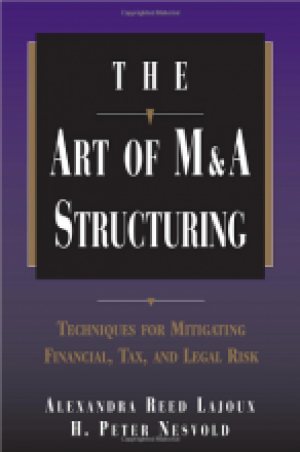
The Art of M&A Structuring
Real-World Guidance to Help You Determine the Most Advantageous Structure for a Merger, Acquisition, or Buyout
By Alexandra Reed Lajoux and H. Peter Nesvold
M&A activity is on the rise again, but the rules of mergers, acquisitions, and buyouts have changed dramatically since the last M&A craze. Today more than ever, a thorough understanding of the intertwined legal, accounting, and tax codes is vital for dealmakers looking to both minimize risk and maximize the potential for short- and long-term profitability.
The Art of M&A Structuring uses the trademark Q&A format of McGraw-Hill's popular Art of M&A series to illuminate the key aspects of this hot-button topic. Let this clear, straightforward treatise provide you with the structural knowledge you need on every important M/A/B aspect:
- Legal--Securities laws; asset versus stock transactions; spin-offs, split-offs, and split-ups; off-balance sheet entities; earnouts; "alternative" M&A structures
- Accounting--Latest FASB statements and SEC disclosure requirements; impact of deal structure on reported earnings; compensation and benefits issues
- Tax--Tax-efficient structures; taxable, tax-free, and tax-deferred transactions; "Morris Trust" rules
The key to the success of any M/A/B transaction lies in the details. The Art of M&A Structuring shows you how to keep details from becoming dealbreakers. Let it help you determine the best approach for measuring and mitigating foreseen and unforeseen risks--and concluding each deal to the satisfaction and benefit of everyone involved.
"M&A is a complex arena. Any given transaction can have literally hundreds of 'moving parts' that must be taken into account as one seeks the best structure for a particular deal. This book identifies the principal elements to be found in an M/A/B structure, and shows their interrelationships."
--From Chapter 1
Mergers, acquisitions, and buyouts have always been among the most complex, fragile, and perilous of business transactions. To add to the confusion, regulators have responded to calls for greater transparency by eliminating key methodologies often used to hide financial risk, such as poolings of interest, and overhauling structuring techniques such as special purpose entities.
The Art of M&A Structuring succeeds at shedding much-needed light on a constantly changing area that continues to be murky at best. Drawing on its authors' unquestioned M/A/B knowledge and experience as well as input from top practitioners and thought leaders, this well-organized, easy-to-follow reference guide asks and answers every vital question. Nowhere else will you find such a detailed yet easy-to-understand roadmap, with clear answers to common questions including:
- "What structuring tools can be used to bridge the buyer-seller valuation gap?"
- "How can I mitigate my tax liability in a taxable transaction?"
- "How can I avoid 'losing my shirt' in a minority investment?"
- "What pitfalls must I avoid in negotiating a strategic alliance?"
- "What should I know before buying a company out of bankruptcy?"
For successful completion of an M/A/B deal, success in the meticulous deal planning and structuring is increasingly necessary to satisfy the numerous, often-conflicting goals of buyers, sellers, investors, and lenders. Whether you are looking for a detailed introduction to this endlessly fascinating field or are currently involved in any of today's myriad and unforgiving types of M/A/B transactions, let The Art of M&A Structuring help you to eliminate unwelcome surprises--and structure a deal that works well today as it passes the critical test of time.
